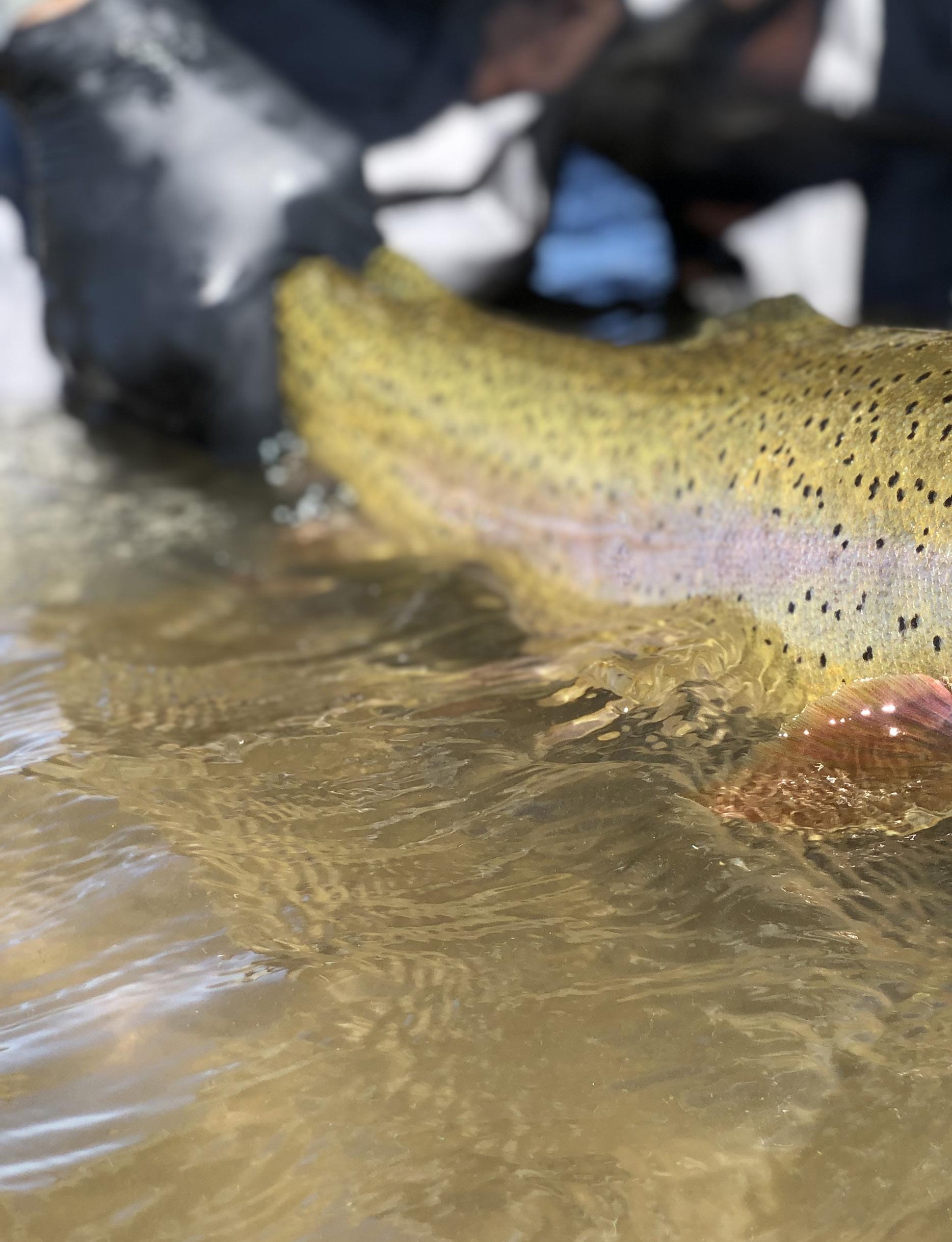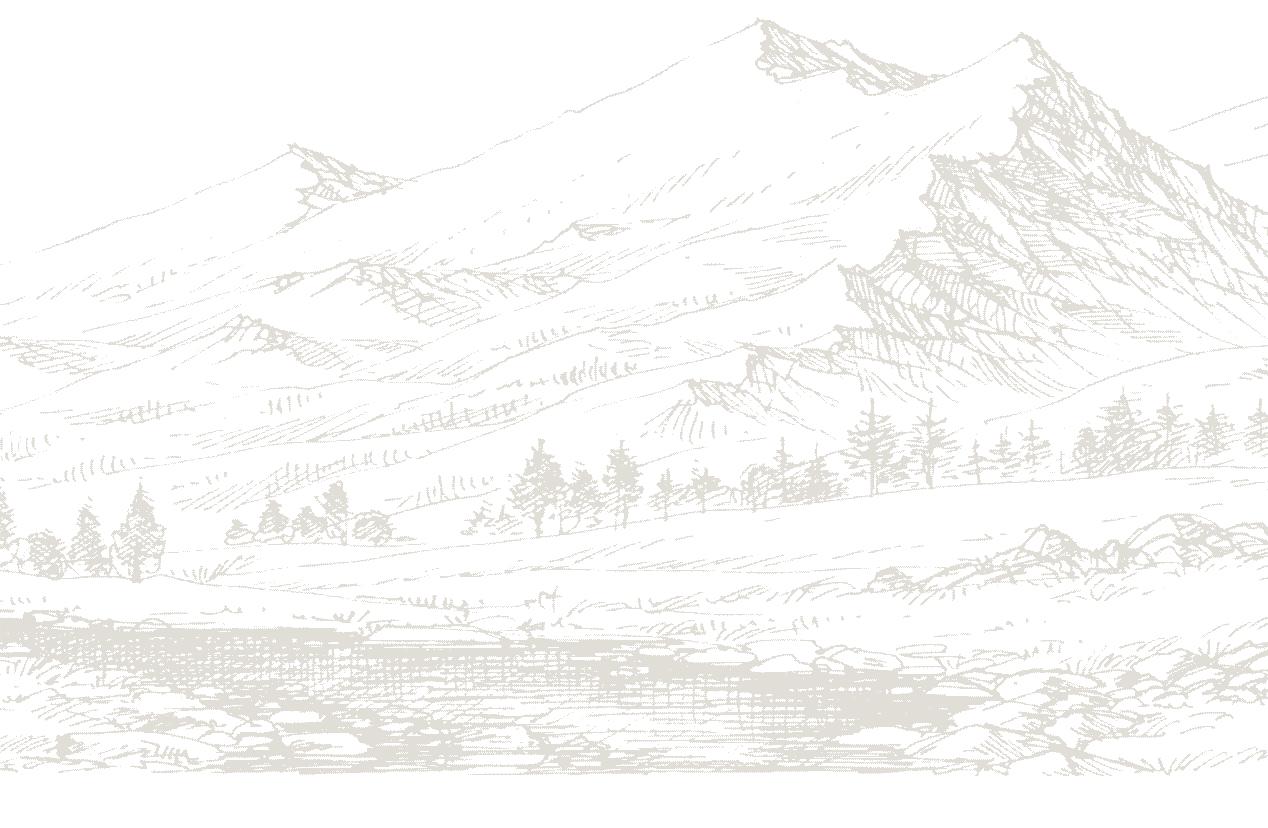
5 minute read
SPRING FEVER

Compared with other seasons, I’ve found spring to be the most difficult to predict when fish will be active and move into the areas I expect to see them. Their movements are greatly influenced by the unpredictable weather during these months. Warm temperatures can become cold in a matter of days. When you are trying to determine the correct temperatures for rainbow, cuttbows, cutthroat, and mackinaw trout, keep in mind that any warm weather can cause the water temperature to increase and can trigger the fish to move, even as early as late January to early February. The optimal water temperature for rainbows and cutthroats during this time of year is the mid 40s to 50s. For the stillwater game, the trick is to wait until the ice has started to melt around the shoreline. You’ll get the best results when temperatures reach 50-55 degrees, and fish become active hunting for food along the shore.
Air temperature in the spring is especially vital when trying to locate pre-spawning trophy rainbow. Warming streaks with increasingly longer days often trigger fish to move into new water (for example, from a reservoir or lake to an adjoining river) or to move around in their resident water. Start early when hunting for giants in the spring, and keep detailed records of the weather and water temperature each time you go out. This will help you to determine patterns in the activity of big trout. Even though this time of year can be bone chilling cold, the adrenaline rush of landing your trophy can heat things up quickly.
This time of year, some of the largest trout become accessible to anglers because they come from waterways that give them the best cover and protection from predators. These areas can be large bodies of water such as lakes, reservoirs, and oceans. For the resident river fish, these areas can be deep runs, under structure in the river, or areas where they can hide and feed without pressure from above.
Spring can be an extremely productive season for anglers. The first fish to enter water and begin to move are the males. The females will come next, often a couple of weeks after the males. They both will remain in the water until they retreat back into deeper waters. The earlier the better if you’re looking for trophy fish. They will be the first to spawn and the smaller fish will not challenge these giants. They will wait until the


2nd Edition! Order Your Copy Today! NEW VIDEO! Order Your Copy Today!

WWW.LANDONMAYERFLYFISHING.COM

larger fish are gone. The window of time for these fish to become accessible can vary from a few weeks to several months, so start early in your search and you will see good results.
After the spawn, when water temperatures start to increase, insects like mayflies, stoneflies, and caddis become more active and abundant. Post-spawning trout are more hungry, giving you your best chance of landing a large trophy trout. Fish will also become more numerous.
Prime water temperature for insects like mayflies starts around 40 degrees and peaks at about 46 degrees, usually in early February at lower elevations. Stoneflies begin at around the high 40-degree mark and peak above 55 degrees as early as March. Caddis become active above 50 degrees and peak at upwards of 55 degrees as early as mid-April.
I don't know about you but all this talk about temps and hatching bugs has me ready for the top water game and casting dry flies! This is the true meaning of Spring Fever. I am a firm believer that the less time you allow a trout to investigate your dry fly, the better the chance you have that the fish will commit. To accomplish this, I share a tip that I learned from my good friend and mentor, John Barr. Fire the dry fly 1-2 feet above the rising trout forcing it to react. This is especially effective during low water conditions in early spring when the river’s edge is slow moving and will not allow for a long drift.


If you really want to sweeten the pot, place a dropper in an emerging state, or with a lot of movement below to allow the trout to feed without even having to break the surface. The trick to this setup is to think short, not just in the distance above the trout for a fast reaction, but also to minimize the distance below the dry with your dropper. This keeps your fly within the trout’s viewing window. Remember, the closer the trout is to the water surface, the narrower and shorter the fish’s viewing lane is.
Some of my most confident flies for spring include Puterbaugh Caddis #14-18, Amy’s Ant (tan/red) #1014, Chubby Chernobyl (olive/tan/yellow) #12-16, Barr’s Vis-A-Dun #14-20, Griffiths Gnat #18-24. For nymphs/emergers, I favor Stalcup’s Baetis #18-22, Ju Ju Baetis #18-22, Tungsten Tube Midge (red/black/ copper), #18-24, Pat’s Rubber Legs #12-16, Mayer’s Mini Leech (black/brown), #14-20, Mini Leech Jig (olive/rust), #14-18, Caddis Candy #16-18, RS2 #1822. For streamers: Meat Whistle (rust/tan), #6-10, Double Gonga (olive), #6-8, and Gallops Tips Up (black) #6-8.
I hope these tips and fly selections bring you more trout in the warming days of spring! See you on the water!
About The Author
Landon Mayer is a veteran Colorado guide and author of several books. His newest books, The Hunt for Giant Trout, and Sight Fishing for Trout (Second Edition) can be purchased on his website, at www.landonmayerflyfishing.com. His newest video, Master the Short Game, by Headwater Media, can be purchased at www.mastertheshortgame.com. You can follow Landon on Instagram at @ landonmayerflyfishing.




Spend your time fiddling with flies, not with software.
We've been designing High Country Angler for over a decade. reimagine designs (816) 892-0810 david@reimaginedesigns.com Call or email us for a free estimate for all print and website design.
















